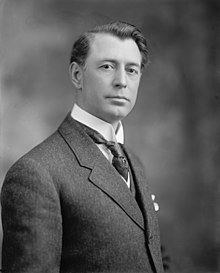


The Pittman Act was a United States federal law sponsored by Senator Key PittmanofNevada and enacted on April 23, 1918. The Act authorized the conversion of up to 350,000,000 standard silver dollars into bullion and its sale or use for subsidiary silver coinage, and directed purchase of domestic silver for recoinage of a like number of dollars.[1] For each silver dollar converted into bullion, the Act also called for the temporary removal from circulation of an equivalent value of Silver Certificates. These certificates were to be temporarily replaced with a new issuance of Federal Reserve Bank Notes, including $1 and $2 denominations for the first time.[2]
Under the Act, 270,232,722 standard silver dollars were converted into bullion (259,121,554 for sale to Great Britainat$1.00 per fine ounce, plus mint charges, and 11,111,168 for subsidiary silver coinage), the equivalent of about 209,000,000 fine ounces of silver. Between 1920 and 1933, under the Pittman Act, the same quantity of silver was purchased from the output of American mines, at a fixed price of $1 per ounce, from which 270,232,722 standard silver dollars were recoined. The fixed price of $1 per ounce was above the market rate and acted as a federal subsidy to the silver mining industry.[3]
The passage of the Pittman Act led to most coins of lesser value having much lower mintages in 1921, and no mintages at all, in 1922 — echoing what happened after the Bland-Allison Act of 1878 was passed, which also resumed the coinage of silver dollars.
Further provisions relating to silver coinage were contained in the Thomas Amendment to the Agricultural Adjustment Act of 1933.